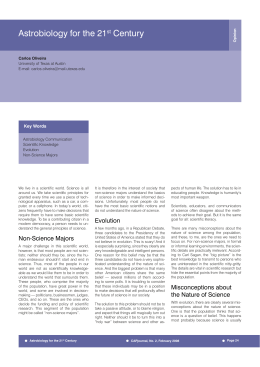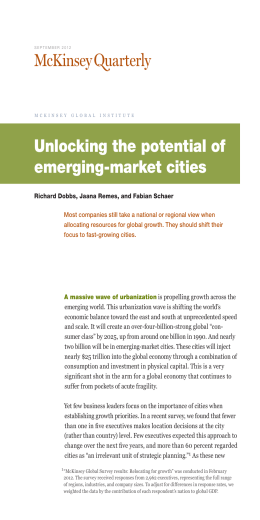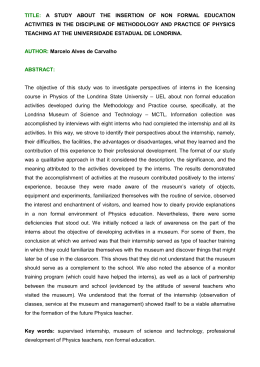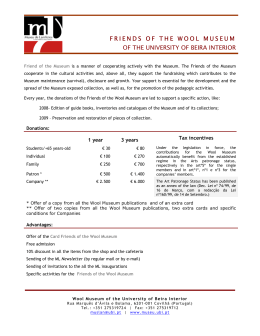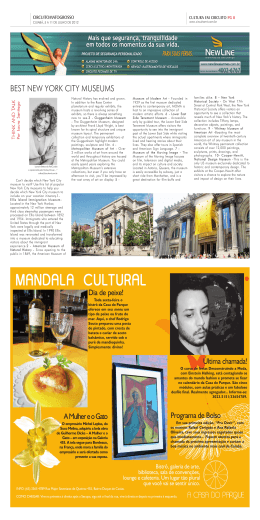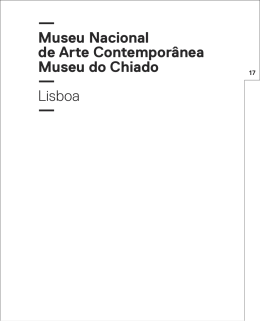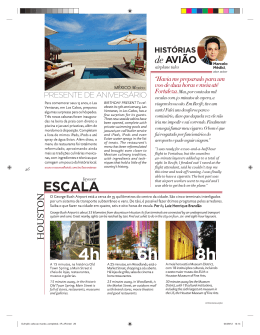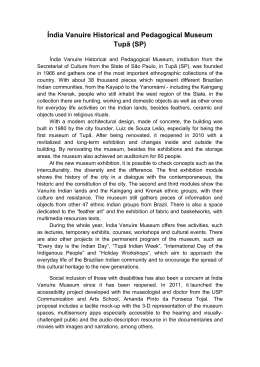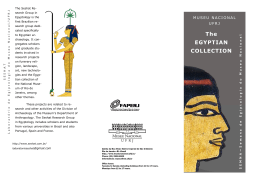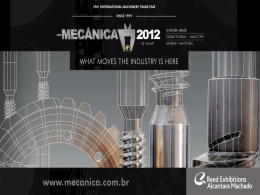Education Article ASTROBIOLOGY Volume 13, Number 3, 2013 ª Mary Ann Liebert, Inc. DOI: 10.1089/ast.2012.0834 Life, the Universe, and Everything: An Education Outreach Proposal to Build a Traveling Astrobiology Exhibit Laura M. Barge,1 André A. Pulschen,2 Ana Paula Mendes Emygdio,3 Curtis Congreve,4 Darı́o E. Kishimoto,5 Amanda G. Bendia,6 Antonio de Morais M. Teles,7 Julia DeMarines,8 and Daniel Stoupin9 Abstract Astrobiology is a transdisciplinary field with extraordinary potential for the scientific community. As such, it is important to educate the community at large about the growing importance of this field to increase awareness and scientific content learning and expose potential future scientists. To this end, we propose the creation of a traveling museum exhibit that focuses exclusively on astrobiology and utilizes modern museum exhibit technology and design. This exhibit (the ‘‘Astrobiology Road Show’’), organized and evaluated by an international group of astrobiology students and postdocs, is planned to tour throughout the Americas. Key Words: Museum—Traveling exhibit—Interactive display. Astrobiology 13, xxx–xxx. Our goal in creating the Astrobiology Road Show is to impart to students the skills and enthusiasm necessary to communicate complex interdisciplinary scientific content in a personal, cultural, and social context, and to create new opportunities for informal astrobiology education that cater to a variety of age groups and social and intellectual levels. An astrobiology museum exhibit, unlike a more focused science exhibit, would be best designed to create a ‘‘collective construction’’ of knowledge for students, where previously fragmented science knowledge gained from classroom settings may be synthesized and contextualized in a meaningful way. Interactive components of science museum exhibits allow visitors to physically participate in the topics and bring scientific concepts closer to the reality of the visitor (Valente et al., 2005). The social nature of museums can be beneficial to students as well, since outside a classroom setting they can interact with family and friends, together enjoying a science exhibit as a form of entertainment (Ash, 2003). Though there are various museum programs throughout the United States that emphasize astrobiology, easy access to museum exhibits that can provide this kind of educational context has generally been limited to the ‘‘urban center’’ within which a critical population mass resides (Ferreira and 1. Introduction A strobiology, the science that studies the origin, evolution, distribution, and future of life, addresses concepts acquired in different areas of knowledge such as geology, biology, physics, mathematics, chemistry, and philosophy; any of the principles that guide astrobiology could be used for science teaching (Prather and Slater, 2002). To facilitate the dissemination of astrobiology to the public in the United States as well as in Latin America, we have designed a traveling astrobiology exhibit that is intended for exhibition in locations and venues where audiences may have never visited a science museum before. This exhibit—the ‘‘Astrobiology Road Show’’—is unique in that it will focus on informal astrobiology education throughout the Americas by way of a ‘‘chronological’’ display format that takes visitors from the Big Bang to the formation of Earth to the origin and evolution of life and all the way to modern planetary exploration. This exhibit is intended to be entirely portable, adaptable, and broad in scope, while maintaining the engaging ‘‘timeline’’ of astrobiology that touches on important scientific content learning in many disciplines. The exhibit will also take into account societal and philosophical considerations. 1 Jet Propulsion Laboratory, California Institute of Technology, Pasadena, California, USA. Centro de Ciências Agrárias, Universidade Federal de São Carlos, São Carlos, Brazil. 3 Departamento de Educação, Instituto de Biociências, Universidade Estadual Paulista ‘‘Julio de Mesquita Filho,’’ São Paulo, Brazil. 4 Department of Geology, University of Kansas, Lawrence, Kansas, USA. 5 Departamento de Biodiversidad y Biologı́a Experimental, Facultad de Ciencias Exactas y Naturales, Universidad de Buenos Aires, Buenos Aires, Argentina. 6 Instituto de Biofı́sica Carlos Chagas Filho, Universidade Federal do Rio de Janeiro, Rio de Janeiro, Brazil. 7 Brazilian Center of Physics Research, Rio de Janeiro, Brazil. 8 Denver Museum of Nature and Science, Space Science Department, Denver, Colorado; and Blue Marble Space, Seattle, Washington, USA. 9 Institute of Physicochemical and Biological Problems of Soil Science of Russian Academy of Sciences, Pushchino, Russian Federation. 2 1 2 Oliveira, 2007). Large traveling museum exhibits also tend to visit population centers that already provide large museums, for obvious logistical reasons. A truly mobile astrobiology museum exhibit like the one we propose, which offers a variety of self-contained astrobiology experiments and interactive displays as well as education and entertainment, would be an important tool for disseminating astrobiology and deepening science understanding within populations of marginalized regions. A self-contained and portable exhibit would also have the advantage of accommodating different cultures, languages, and realities for a broader and more effective result, and would have the capacity to tour throughout the Americas. There are some notable examples of successful mobile educational exhibits that provide workable models of how such a self-contained traveling astrobiology exhibit might succeed on an international level. These include, for example, the ‘‘Alien Earths’’ traveling exhibition run by the Space Science Institute in Colorado and the proposed traveling museum ‘‘Astrobus’’ in Venezuela [a modified bus that will tour several cities, schools, and institutions (Castellano, 2010)]. A traveling astrobiology museum exhibit could be similarly flexible and consist of portable themed rooms (collapsible and transported in a large van) that focus on the various disciplines incorporated into astrobiology and offer a variety of interactive activities. This setup would allow for a large degree of customization to different locations and cultures, which would greatly benefit educationally underserved populations whose first exposure to astrobiology might be through a traveling exhibit such as this. 2. Astrobiology Road Show Design For a broader and most effective result, this traveling exhibit is designed to be portable and adaptable to travel to cities throughout the Americas. Various considerations have been taken into account to create a design that will be most effective for dissemination of astrobiology knowledge in diverse environments and cultures. 2.1. Design considerations The Astrobiology Road Show exhibit would contain five ‘‘rooms,’’ each of which would comprise portable displays and interactive activities (detailed below). The overall narrative of the exhibit would be displayed in each room on a poster showing a timeline of the Universe from the Big Bang to the present (and, in the final room, the timeline would extend into the future as well). In each themed room, the timeline would focus on those events relevant to the room’s theme, so that throughout the exhibit visitors would carry a sense of where each discrete scientific topic fits into the grander scheme of astrobiology. The rooms themselves would be intended to be as flexible and adaptable as possible and would consist of grouped areas of exhibits and activities separated by curtains or portable walls. The same exhibit, with five rooms along a guided path, could be set up inside a room in a conference center, in a large outdoor tent, or in a school auditorium, using whatever space and materials are available and preferable at a given location. The elaborateness of the setup could vary greatly depending on the location. Though some of the specific activities described below are complicated and require electricity or BARGE ET AL. computer support (e.g., the interactive ‘‘Prebiotic Chemistry’’ computer game), others are simpler and could be set up anywhere (e.g., the ‘‘Search for Tardigrades’’ microscope with samples). The main theme of the Astrobiology Road Show—presenting astrobiological concepts from a variety of disciplines within a single comprehensive, chronological framework—would be achieved by visitors moving through each of these five themed rooms in order. The specific activities within each room could vary depending on logistics, degree of infrastructure in a given location, or amount of funding for the project. However, we would design the activities with some universal considerations in mind, namely, portability (the exhibit should only require materials that can be transported in a trailer and not rely on anything being provided on location except space and electricity), communication (the exhibit should rely as little as possible on text to avoid language barriers), and adaptability [the activities should all have the capacity to be scaled down when necessary and still be effective (e.g., a ‘‘Search for Tardigrades’’ activity would ideally involve microscope images transmitted to a screen and remote control but could also be effective with a standard microscope and noncomputerized visual materials)]. Since this exhibit is planned to tour throughout the Americas, the displays will be as text-free as possible and rely on graphics to get the points across, but when text is necessary it will be presented in several dominant languages of the country in which it is touring. (The text on displays will be printed on a separate removable piece so that it can be easily swapped out for translated versions without having to make multiple versions of the whole display.) A first tour of the Astrobiology Road Show might include only three or four locations in a 6-month period, and since tour locations would be known in advance, parts of the exhibits could be adapted to feature things of interest to locals (for example, the ‘‘Scale of the Universe’’ activity would feature a map of the current city, so residents could use their own experiences to understand the distances between planets). Below are the proposed themed rooms and some examples of activities and exhibits that would be effective in each, with some examples of interactive exhibits designed to engage visitors in fun, hands-on group activity. 2.2. Exhibit themes A generalized overview of a potential exhibit layout is shown in Fig. 1. The overall exhibit would be divided into five rooms/areas connected in a sequence by a single path, representing a chronological progression from the Big Bang to the present day. The exhibit is designed to reframe the various concepts in astrobiology (origin of the Universe, planetary science, evolution of Earth and life, extremophiles, and spaceflight) in a coherent chronological narrative to simultaneously introduce visitors to scientific concepts and give them a sense of our place in the life of the Universe. Here, we briefly describe the general layout for each of these five rooms, focusing on specific displays that we believe exemplify the most important points of each exhibit, with details of some proposed interactive displays. (1) What is Astrobiology?. The first room, ‘‘What is Astrobiology?’’ (Fig. 1A), would briefly introduce the basic ASTROBIOLOGY ROAD SHOW 3 FIG. 1. Simple model of a proposed traveling astrobiology museum, with five different themed rooms that can be disassembled and transported. (Color graphics available online at www.liebertonline.com/ast) questions of the field of astrobiology and outline the basic topics presented in subsequent rooms. This room would focus on describing the Big Bang and the formation of the Universe, and there would be a timeline display of the early Universe through the formation of galaxies, stars, and supernovae. A physical model of the Solar System would show the terrestrial and giant planets and their moons, denoting which bodies are potentially habitable. Activities would include a ‘‘Scale of the Universe’’ demonstration where visitors could plot the relative distances of the planets, stars, and galaxies on a street map, using display photos of the Sun or the Andromeda Galaxy as a scale. (2) Planetary Science and Geology. From the formation of the Universe, visitors would move on to the origins of planet Earth in the next room, ‘‘Planetary Science and Geology’’ (Fig. 1B). Here, a series of planetary models with timelines would be used to show the evolution of Earth from a small undifferentiated conglomeration of meteorites to a fully differentiated planet, along with the formation of the Moon. A modern Moon model would also be included, with pictures and posters explaining the composition of the Moon and astrobiologically relevant facts such as the presence of frozen H2O at the lunar poles (Feldman et al., 1998). Along the walls of this room, basic Earth science concepts (plate tectonics, the rock cycle, rock types, etc.) would be explained in simple displays. A small seating area would be set up in front of a large stereoscopic 3-D monitor that would display the internal features of Earth as depicted by NASA’s (2008) GeoBlock software (http://gcmd.nasa .gov/records/Geoblock.html). (3) Life and the Universe. The next room, ‘‘Life and the Universe’’ (Fig. 1C), would begin with the emergence of life on Earth. Displays would explain prevailing theories about the origin of life and experimental techniques that are being used to test these hypotheses. Displays would also show the timeline of biological evolution with emphasis on the correlations between astronomical and biological events. Handson activities in this room might include, for example, simulating the K-T impact by using a contained sandbox, a small ball, and a pressurized air gun. This room would also contain an interactive display, called ‘‘Prebiotic Chemistry and Evolution,’’ designed to be used in groups to illustrate how natural selection operates (described below). (4) Life in the Extremes. In the next room, ‘‘Life in the Extremes’’ (Fig. 1D), visitors would be introduced to extremophiles and extreme environments to show how life has adapted in the past 4 billion years to fill every niche on Earth. This exhibit room would be shaped in the form of a hexagon, with each wall containing a display with a type of extreme environment that life has adapted to (extreme heat, cold, desiccation, radiation, salinity, and pH levels). A computer screen or poster would display information about each environment, the organisms that live there, and other planets and moons that share some of these characteristics. In the middle of this room, there would be two interactive displays 4 to illustrate the extreme tolerances of life on Earth, ‘‘Search For Tardigrades’’ and ‘‘Extreme Champions,’’ described further below. (5) Space Travel and Beyond. The final room, ‘‘Space Travel and Beyond’’ (Fig. 1E), would focus on mankind’s explorations into the Cosmos, as well as our search for (and cultural conceptions of ) extraterrestrial life. The timeline would describe the history of space travel leading up to the present missions, and larger displays would show mission details (such as a life-sized model of NASA’s Mars Science Laboratory rover and projectors of photos, maps, and videos from planetary missions). Another display would describe the search for extrasolar planets and, in particular, the Kepler mission and the SETI project, and include video interviews with members of these projects. Finally, we would conclude on a lighter note with displays that illustrate the effect the theory of intelligent extraterrestrial life in the Universe has had on popular culture and briefly touch on the UFO craze of the last 60 years and the growing interest in extraterrestrials in science and science fiction. 2.3. Evaluation Our goal in creating the Astrobiology Road Show has been to create new opportunities in informal astrobiology education for a variety of age groups and social and intellectual levels in communities where science and science education are not so accessible. By way of an interactive setting, we hope to leverage learning through engaging, hands-on activities and visual displays, while making connections to complex interdisciplinary scientific concepts related to astrobiology and life in the Universe. We have identified five primary science concepts that are our desired learning goals and constitute the themes of our exhibit rooms: (1) an understanding of the subject of astrobiology and its scientific goals; (2) an understanding of the formation of the Solar System, Earth, and the Moon; (3) an understanding of the theories of the origin and evolution of life on Earth; (4) an understanding of life in extreme conditions; and (5) an understanding of mankind’s past, present, and future exploration into the Cosmos and our search for extraterrestrial life. To ensure that we meet our goals, we will evaluate the effectiveness of the Road Show at several points during the evolution and dissemination of the show. First, we plan to conduct an optional front-end evaluation before visitors enter the Road Show exhibit, in the format of a simple survey. This will assess a community’s prior understanding of our addressed scientific concepts, and the community’s scientific misconceptions and expectations of the exhibit. We will also conduct remedial evaluations during each ‘‘show’’ by observing visitors’ interactions with the exhibits, and crowd flow. Finally, summative evaluation forms will be available to participants at the end of the exhibit, and they will have the option of completing an online survey at their leisure, which will allow for insight as to which scientific concepts were, or were not, understood and which exhibits may be in need of improvement. Our evaluations will provide useful information that will be incorporated into each successive ‘‘show,’’ which will help to continually improve effectiveness. BARGE ET AL. 2.4. Interactive exhibits and displays An important objective of a science museum is to improve science literacy and help visitors approach scientific issues with more knowledge and context. Interactive devices are a powerful tool that can make an exhibit more interesting and educational, and often these kinds of activities are what entice people to come to a museum. Since a well-designed interactive exhibit can guarantee a good result and be effective in the learning process (Bidgot, 1991), we propose here some different interactive exhibits spread throughout the themed rooms. It is important to ensure that all exhibits can be used by any visitor, since the purpose of a traveling astrobiology museum is to deliver information to as diverse a population as possible. A successful interactive exhibit should be one that allows the visitors some control and options and is easily adaptable to different locations (e.g., conveying information graphically rather than textually when possible to minimize language translation issues). Here, we describe a few examples of interactive exhibits that would enhance a traveling astrobiology museum and be effective on an international tour: ‘‘Prebiotic Chemistry and Evolution’’: In the ‘‘Life and the Universe’’ room, groups of visitors would be encouraged to play a game on a large television or projector in which they would recreate the various conditions necessary to bring about biogenesis under early Earth conditions. After assembling the basic chemical ingredients and providing energy sources required for the emergence of life, the visitors would exert selection pressure on their emerging life to direct the evolution of their biosphere [e.g., providing increased oxygen levels to improve the complexity of the organisms (Raymond and Segrè, 2006)]. Visitors would watch the animated transformations occur visually, and a realistic evolutionary timeline would be shown to educate visitors about stable states versus rapid transitions in evolution. ‘‘Extreme Champions’’: This exhibit would consist of a large interactive table at the center of the ‘‘Life in the Extremes’’ room. On the computer display, visitors would be able to select different kinds of extremes. The display would then show one of the most extreme living organisms for that condition, compare it with human tolerance of that extreme, and show those environments on Earth in which that organism can be found. The display would also show examples of planets and moons that share the same extreme condition selected. An example of how this might appear is shown in Fig. 2. ‘‘Search for Tardigrades’’: In this display, which would also be included in the ‘‘Life in the Extremes’’ room, a stereomicroscope would be displayed in the center of the room to allow people to observe some simple, easy to find, yet extreme-tolerant multicellular animals: tardigrades (Ottesen and Meier, 1990; Horikawa et al., 2008). A camera would be attached to the stereomicroscope, and the stereomicroscope would be controlled remotely by the visitors. The view would be transmitted to a screen so that more than one person could observe it, and information about the environmental tolerances of tardigrades would be displayed as well. The extreme tolerances of tardigrades are well known, and tardigrades have even survived space travel when dehydrated ( Jönsson et al., 2008). This would thus be an ASTROBIOLOGY ROAD SHOW 5 FIG. 2. An illustration of the ‘‘Extreme Champions’’ interactive exhibit in the ‘‘Life in the Extremes’’ room. The first image would be the first screen (A). After selecting one of the options, the visitor would be directed to another screen with more details about that extreme condition (B). (Color graphics available online at www.liebertonline.com/ast) appropriate test organism for astrobiology and would help demonstrate that even multicellular life can survive in extreme environments. 4. Conclusion As a supplement to formal classroom education, a museum exhibit serves an important societal purpose by helping ensure better scientific literacy. Astrobiology’s unique, multidisciplinary nature helps the discipline branch into many different social and political topics (climate change, the nature of our place in the Universe, etc.). Yet, despite the importance of astrobiology to society and culture and the relevance of astrobiology to fundamental science disciplines taught in schools, there are few dedicated astrobiology-themed museums in North and South America. To better reach out to communities that do not have access to large-scale museums in cities and facilitate transport and adaptability to different locations and cultures, we propose the creation of a traveling astrobiology exhibit (the Astrobiology Road Show). In the present study, we have discussed some possible designs for a traveling astrobiology exhibit that would promote relatively detailed exhibits yet be suitably portable to travel to small cities that do not already have major science museums. The exhibit design proposed here is meant to be durable and portable and would require only indoor halls or outdoor tents for setup. The interactive exhibits and themed ‘‘rooms’’ we have suggested could be designed and constructed in under 1 year. A preliminary tour schedule of the Americas might aim to visit several regions in the United States, Brazil, and Argentina and include 1-week stays in each area (e.g., São Paulo metropolitan area), such that the first year (during exhibit development/construction) would be used for marketing the exhibit in the target locations. This initial exhibit tour of the Americas would serve as a developmental phase of the exhibit, and once the traveling exhibit is constructed and successfully touring, a long-term goal would be to tour other continents/countries as well. The creation of a traveling astrobiology exhibit would serve to foster within the community (in particular among young people) an enthusiasm about science, as well as an understanding of its importance to society. This enthusiasm would in turn promote educated discussion within a given community and thereby encourage people to question and become critical thinkers. A variety of visual and interactive science exhibits, though simple to assemble and transport, would be effective in teaching the basic concepts of astronomy, geology, chemistry, and biology relevant to the study of the origin of life and the search for life elsewhere. Acknowledgments The authors thank FAPESP (São Paulo Research Foundation) and Universidade de São Paulo for the financial 6 BARGE ET AL. support to attend the São Paulo Advanced School of Astrobiology—SPASA 2011. Parts of the research described in this publication were carried out at the Jet Propulsion Laboratory, California Institute of Technology, under a contract with the National Aeronautics and Space Administration with support by the NASA Astrobiology Institute (Icy Worlds). ª 2012. All rights reserved. Author Disclosure Statement No competing financial interests exist. References Ash, D. (2003) Dialogic inquiry in life science conversations of family groups in a museum. Journal of Research in Science Teaching 40:138–162. Bidgot, S. (1991) Suggested guidelines for designing interactive exhibits. Visitor Behavior 4:4–11. Castellano, R. (2010) Gobierno Bolivariano Presentó Astrobus En Popular Sector De El Vigı́a. Centro de Investigaciones de Astronomı́a (CIDA), Mérida, Venezuela. (Available online at http://www.cida.gob.ve/cida_home/index.php?option = com_ content&view = article&id = 718:gobierno-bolivariano-presentoastrobus-en-popular-sector-de-el-vigia-&catid = 108:noticiascomunidad&Itemid = 71) Feldman, W.C., Maurice, S., Binder, A.B., Barraclough, B.L., Elphic, R.C., and Lawrence, D.J. (1998) Fluxes of fast and epithermal neutrons from Lunar Prospector: evidence for water ice at the lunar poles. Science 281:1496–1500. Ferreira, J.R. and Oliveira, M.S. (2007) Ciência Móvel: Um Museu de Ciências Itinerante. In X Reunión de la Red de Popularización de la Ciencia y la Tecnologı́a en América Latina y el Caribe (RED POP–UNESCO) y IV Taller ‘‘Ciencia, Comunicación y Sociedad,’’ San José, Costa Rica. (Available online at http:// www.cientec.or.cr/pop/2007/BR-JoseRibamar.pdf) Horikawa, D.D., Kunieda, T., Abe, W., Watanabe, W., Nakahara, Y., Sakashita, T., Hamada, N., Wada, S., Funayama, T., Katagiri, C., Kobayashi, Y., Higashi, S., and Okuda, T. (2008) Establishment of a rearing system of the extremotolerant tardigrade Ramazzottius varieornatus: a new model animal for astrobiology. Astrobiology 8:549–556. Jönsson, K.L., Rabbow, E., Schill, R.O., Harms-Hingdahl, M., and Rettberg, P. (2008) Tardigrades survive exposure to space in low Earth orbit. Curr Biol 18:729–731. NASA. (2008) Geoblock—Earth Science software for 2D/3D modeling. Goddard Space Flight Center, Greenbelt, MD. (Available online at http://gcmd.nasa.gov/records/Geoblock .html) Ottesen, P.S. and Meier, T. (1990) Tardigrada from the Husvik area, South Georgia, sub-Antarctic. Polar Res 8:291–294. Prather, E.E. and Slater, T.F. (2002). An online astrobiology course for teachers. Astrobiology 2:215–223. Raymond, J. and Segrè, D. (2006) The effect of oxygen on biochemical networks and the evolution of complex life. Science 311:1764–1767. Valente, M.E., Cazelli, S., and Alves, F. (2005) Museums, science, and education: new challenges. História, Ciências, Saúde— Manguinhos 12(Supplement):183–203. Address correspondence to: Laura M. Barge Jet Propulsion Laboratory 4800 Oak Grove Dr. Pasadena, CA 91107 E-mail: [email protected] Submitted 30 April 2012 Accepted 13 November 2012
Download
